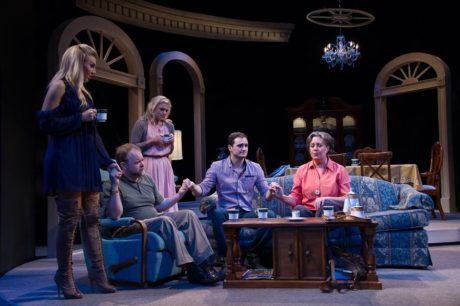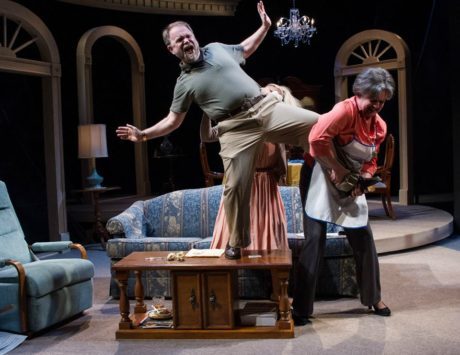What is it that’s so tried and true about plays about siblings? Must be something universal, because there are so gosh darn many of them. Structurally they obviously make for auspicious cast lists, characters with built-in back stories of tensions and lingering resentments. A playwright has only to put the brothers or sisters in the same room and something dramatic or comedic is sure to happen, right? But what is it about plays centering on siblings that so connects and cathects us?

I was prompted to this rumination after seeing Theater J’s sharp staging of Deborah Zoe Laufer’s The Last Schwartz, the acrid comedy that kicks off the first season curated by new Artistic Director Adam Immerwahr. From its very first scene, The Last Schwartz delivers us into a curious disequilibrium between laughing and cringing, then leaves us to sort out our uncertainty on a scale encompassing the cosmos. Yup, it really goes there. It takes our spinning heads from a living room to the moon.
But you don’t know that at the beginning, when Bonnie (Anne Bowles) is telling her distracted husband Herb (Sasha Olinick) about an Oprah show she watched that featured two twin girls whose bodies were inoperably conjoined. Herb isn’t listening, he’s absorbed in reading a newspaper; but we sure are. Bonnie is cracking quasi-tasteless jokes about the sisters’ plight (which we don’t know whether to laugh at or not) and then abruptly shifting mood to tell us how inspiring the girls are when they tell Oprah undauntedly they would never want to be separated and they each want to have children someday. Suddenly Bonnie’s mixed-signal monologue careens to her overweening grief over her childlessness (she has miscarried five times) and her sorrowful longing to have a connection as lasting and empathic as these two sisters’.
Yikes. I don’t recall a show that so had me chuckling, wincing, and emotionally wrenched all at once from the get-go.
And so it goes as The Last Schwartz unfolds—joshingly, jarringly, engagingly—with three grown brothers and a sister, who comprise a divided and distrustful Jewish family, converging on their deceased parents’ home, ostensibly to observe their father’s yahrzeit, the anniversary of his death.

“Why aren’t we a real family?” Norma the sister (Barbara Pinolini) asks no one in particular.
“This is what a real family is” her brother Herb shoots back at her.
Norma is the only sibling taking this yahrzeit seriously, and she is peeved at the others’ indifference. Her annoyance escalates when Gene, her youngest brother and a TV commercial director (Billy Finn), arrives with Kia, his shiksa bimbo wannabe-starlet girlfriend (a hilarious Emily Kester). No love is lost either between Norma and Bonnie, Herb’s emotionally volatile wife, who converted to Judaism for him. The only sibling who gets a smidgen of Norma’s sympathy is Simon (Andrew Wassenrich), a possibly autistic astronomer who is going blind and spends most of the play in isolation staring into a telescope remembering constellations from when he could see.
Norma the family morals maven is estranged from her ex-husband and son because she called the cops on the boy when she found him smoking pot. Kia has no intention of birthing a baby because she’s a spokesbody in a “Fat No More” commercial. Meanwhile Bonnie’s babyless desperation lends the play an undercurrent of pathos. “I want a child!” Bonnie wails. “I want to be a family!” And there’s something both disturbing and almost farcical about the lengths to which Bonnie goes to try to make that happen.
As it turns out, the title The Last Schwartz refers specifically and significantly to this airless Jewish family’s heirlessness, and by extension it evokes Jews’ tenuous-for-generations hold on earthly survival. “To keep the family alive is to keep faith alive,” Norma pronounces—a point the play both plays with for our amusement and drives home unsettlingly for our reflection.

Why does The Last Schwartz make such recognizable sense, yet why is our response to this funny/serious play so complicated? The answer is a familiar connection that a whole lot of folks can relate to. It’s the sibling thing. And it’s why The Last Schwartz at Theater J rings true on stage with amazing reverberation in the mind.
Running Time: Two hours, including an intermission.
The Last Schwartz plays through October 2, 2016 at Theater J at The Washington DCJCC’s Aaron & Cecile Goldman Theater –1529 16th Street, NW (16th and Q Streets), in Washington, DC. For tickets, call the box office at (202) 777-3210, or purchase them online.





